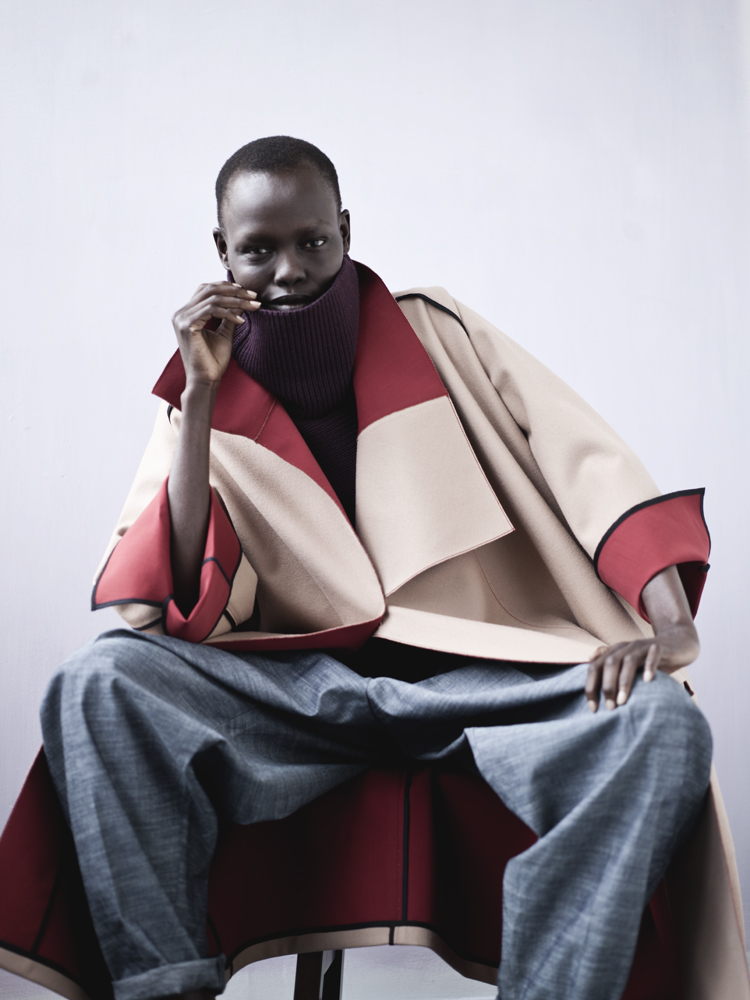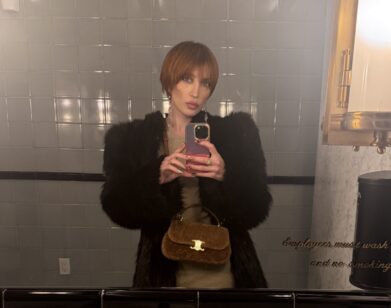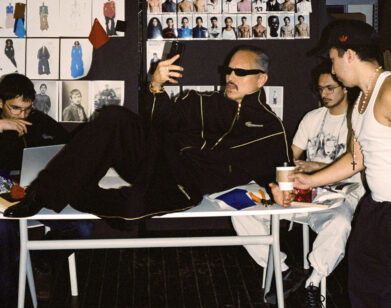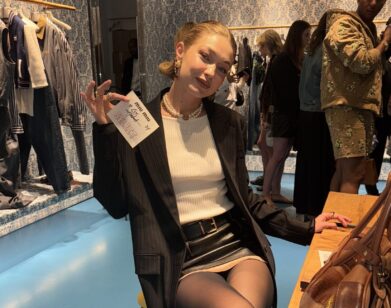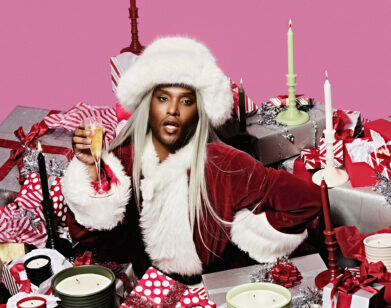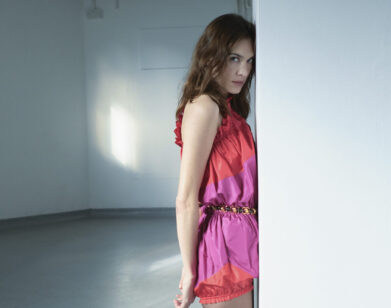Models Off Duty: Grace Bol x Tome
ABOVE: GRACE BOL IN NEW YORK, APRIL 2014. ALL CLOTHING: TOME. PHOTOS: VAN SARKI. STYLING: COLUMBINE SMILLE. STYLING ASSISTANT: LIANA VASSEROT.
For their Fall/Winter 2013 collection, Australian design duo Tome created a campaign video starring Sudanese-American model Grace Bol. Against a bone-ivory background inspired by Georgia O’Keefe’s animal skulls, Bol was lithe and graceful in a flowing deep scarlet dress, commanding in a dark hat and shearling coat, and transcendent in white. Bol has been a friend of the label’s ever since.
Founded by Ryan Lobo and Ramon Martin in 2011 (which was, coincidentally, the year Bol’s modeling career took off), Tome is flourishing. Yesterday, Tome debuted its first-ever resort collection.
On Friday evening, Lobo and Martin took a brief break from their Resort 2015 preparations to talk with Bol at their studio in New York.
RYAN LOBO: Well, it’s nice to see you.
GRACE BOL: Great to see you, too.
LOBO: I think last time I saw you was in Paris, and Fashion Week.
BOL: Yes.
LOBO: At the end of the trip, when everyone was exhausted and ready to go home.
BOL: Yeah. [laughs]
LOBO: What have you been doing since then, since March?
BOL: I stayed a little bit in Paris, actually, to do some shoots. Then I came here and just traveled one time to Germany. What have you guys been doing since last time I saw you in Paris?
LOBO: Since March, we’ve taken on a whole lot of new projects for us.
RAMON MARTIN: Yeah, we’ve been really busy with launching our first resort, which is very exciting. We’re also launching the White Shirt Project, so we’re also teaming up with Katie Ford and Freedom for All, which is an amazing foundation that fights against human trafficking and modern-day slavery. We’re actually doing a launch for that on the 10th of June, which you should come to! All the profits from the sales of the shirt that we’re selling on Net-A-Porter go to Freedom for All.
LOBO: Katie’s work is to emancipate people who’ve been involved in human trafficking and modern day slavery—men, women, children. The idea is, with the project, that we will sell a white shirt every six months, and the proceeds will go towards the charity. More importantly, it’s about trying to raise awareness for what the foundation is doing and the fight that they have; the fact that it doesn’t just happen elsewhere in the world, that it actually happens in America and America is one of the biggest hubs for the trafficking of people, especially women, in the world. So it’s an important thing and that’s why we want to do it. We met Katie about two years ago and have always planned to do something with her. Finally the time was right. You must come.
BOL: What does the t-shirt look like? What does it represent?
MARTIN: We decided to do the white shirt just because we started in shirting and it was a nice metaphor for the clean slate—each of the people that Katie’s foundation helps, once they’re emancipated, it’s a new start for them.
BOL: It looks really nice. It looks almost like a nun outfit. [All laugh] I mean in a good way! It’s good to represent the peace.
LOBO: Lots of incredible ambassadors are coming to the event or supporting the event, and maybe you’ll be one of them as well! China Chow is going to wear a white shirt. Who else is wearing a shirt?
MARTIN: Jessica Hart.
LOBO: Jessica Hart, Taylor Tomasi Hill, Jenna Lyons. All of these wonderful women who have been supporters of the brand and have become friends of ours through time in the industry are coming out and showing their support.
BOL: I like the shirt. I liked the way it looked. You could wear it with a pair of jeans or slick pants. [laughs]
MARTIN: It’s our first party as well!
LOBO: It’s our first party.
MARTIN: So it’s fun. We’re very excited. We’re throwing our first party, after…
LOBO: After three and a half years of hard slog. What’s your story? Where are you from, where’s your family from, how did you end up in New York?
BOL: I’m originally from Sudan, which has become South Sudan now, and I grew up in Kansas City, and I moved to New York almost five years ago now.
LOBO: When did you come to Kansas?
BOL: When I came to Kansas City, it was ’99—Christmas of ’99. We had a war in our country—it’s still continuing now, again. We left for that. My father died, my mom would take care of us. My mom was a single mom. We were at a refugee camp and then the UN put us in Kansas City.
LOBO: So you came to America as a refugee?
BOL: Mmhmm. That’s why we were in the United States. I chose to come to New York on my own, and came.
MARTIN: Wow.
BOL: I had a big family. My father had a second wife—my mom is the second wife, so all of us together is 13.
MARTIN: Oh my God.
LOBO: That’s huge.
BOL: Yeah, it was 13. Now it’s down to 10.
LOBO: How many are in America?
BOL: Most of them are. One is in Vegas, the rest in North Dakota, some of them are in Kansas, and I’m here. [laughs]
LOBO: How did you begin modeling? What was the lucky moment?
BOL: [laughs] The story is silly. I was in a mall with my friends, shopping, and then they had an open call somewhere and everyone from the store was like, “Did you go downstairs? There’s this thing happening, you should go,” and I was like, “Oh, whatever.”
I went and tried out and they told me, “Oh, you could do this.” I wasn’t sure. But after a while they were like, “You’re too high fashion. You should go to London or New York.” Because there was nothing going on in Kansas City. But I wasn’t sure. I kept asking them, “Are you sure this is for me?”
MARTIN: What was your hesitation?
BOL: I just didn’t know anything about fashion. That was the main thing. And they said I was right for it and I didn’t know for what—what did I need to do. I choose to come to New York because it was closer to my family and I could go back and forth if things went wrong. But I fell in love with New York and I stayed here.
MARTIN: And things are going right.
BOL: Yeah, every year is completely different. In 2009, I walked my first show. I was scared. After that, I had agency problems—I never got to the right people until 2011. Then I went to Paris and I believe my big break would be Givenchy. I did the show for the first time and everything just fell in place.
LOBO: And now everyone loves you. I think you’re the darling of Albert Elbaz and Rick Owens.
BOL: Yeah, I hope.
LOBO: And Tome! [laughs]
BOL: [laughs] Yes, yes, yes. Everything is shocking. I’m just surprised every time when I get the news, like “You’re confirmed for this,” or “You’re seeing this person.” Sometimes just going through the magazines or seeing the names. You never know where you could be. But so far, it’s great. Tell me about yourselves, both of you!
MARTIN: How we started?
BOL: Yes.
LOBO: We grew up in Australia. I was born in India, but I moved to Australia with my family when I was five. Then we met at fashion college when we were 18 or 19, in Sydney, and became fast friends. [We] traveled the world and did lots of different things together and separately. We decided that one day we would come together and do something together and obviously it was going to be fashion and obviously it would be a brand. We just didn’t know at the time what that would be. I guess our collective experience has informed what the brand has become, what we’re doing with it. Ramon will tell you about his background, as well, of design, travel.
MARTIN: We jumped around all over the place, actually. Between us, we’ve lived in so many places—London and Paris and Sydney and now New York.
LOBO: We came together in 2010 and decided we would launch something in New York in 2011. Ramon was already living here. I moved from Sydney, and it’s just been an incredible experience since then. Everything’s going really well; sales are really strong. As Ramon said, we’re about to launch our first resort. We had our first presentation, which you, of course, were the absolute centerpiece of.
BOL: That was your first?
LOBO: Yeah, yeah.
BOL: Oh my God. That was so much nicer. I love it. I love how you guys did the video afterward.
LOBO: It’s kind of nice when we work with people who also influence what we do. I don’t know if you remember, but when you came in and Ramon literally created the dress around you?
BOL: Oh, yes, I remember!
LOBO: It’s not always that it happens that way but sometimes something special happens at midnight the night before a show and all of the sudden something’s created because of—
MARTIN: Always midnight.
LOBO: —Because of a lot of different reasons. Because of a special person, you know, behind the scenes, or a special beauty or a special creature or character. That was our first presentation. We had one more after that. We had our first show since then, which was really amazing, February this year, and of course the next one in September, and it just keeps going.
BOL: What are you guys going to do for the summer?
LOBO: We’re both going be here—take turns going out to Fire Island for a week or a weekend or something like that. Just have a very quiet existence.
BOL: I’ve never been to Fire Island. I always missed it. I make plans, and then I don’t make it.
LOBO: It’s a New York gem. It’s really amazing. We’re used to being in Australia where, no matter where you are, you’re 15 minute’s drive from the beach. So it’s a very different thing to have to travel to be near the water. Especially in the middle of summer. But once you’re there, it’s worth it.
MARTIN: Completely.
BOL: My country is in the middle of the continent, so the only thing we have is a river, which is not so nice.
LOBO: Do you think you’ll ever visit again? Would you like to visit the Sudan again?
BOL: I would love to visit now. I was going to go in December, but December 15, that’s when the war started. The silly war. So just waiting for everyone to calm down and hopefully I’ll be able to go and see family.
We should go back to fashion. What are your favorite pieces so far?
LOBO: Well, we made our name with shirts. That was the first thing we did. I think because we’re two men who make clothing for women, shirting is something that means something to us as well—we wear shirts every day. We have an affinity for the shirt. People responded to our take on the shirt, our take on the white shirt, our take on variations of the white shirt. So that’s something that even to this day, almost four years later, people think of Tome, they think of a shirt. I think that’s an important thing for the DNA of the brand. But we have a lot of signatures that are actually quite present in the resort collection—it’s kind of a culmination of what we’ve been doing for the last three years. There’s a print that has a motif from the very first collection. All of the Tome signatures are there: French lace, taffeta, lamé, interesting combinations of color, masculine meets feminine. Those are all the things that are important. But I guess, if it came down to it, probably the cornerstone of the collection is a shirt.
BOL: It looks awesome. I like how it’s not too fitted because anybody can wear it. You don’t have to worry about your waist so much.
LOBO: Yeah, we like to make shapes that accommodate lots of different shapes. We don’t ever sit down and say that we have to make sure we have some sexy things or some body-conscious things in the collection. There’s something more subtle about how we appreciate that women want to dress—it’s a little bit more free in the attitude, I think. You can wear whatever you want and in your own way.
GRACE BOL IS REPRESENTED BY ELITE. FOR MORE FROM OUR MODELS OFF DUTY SERIES, CLICK HERE.

